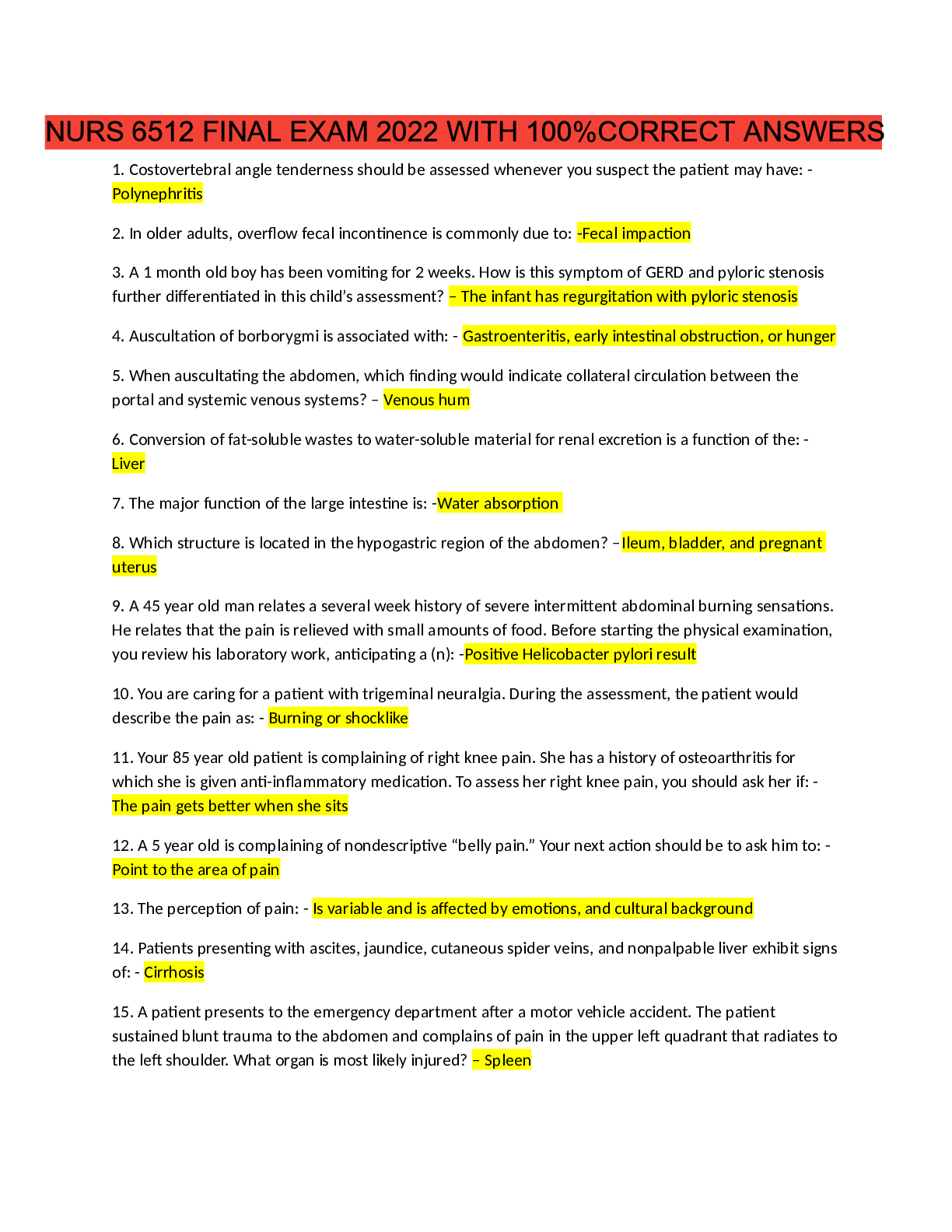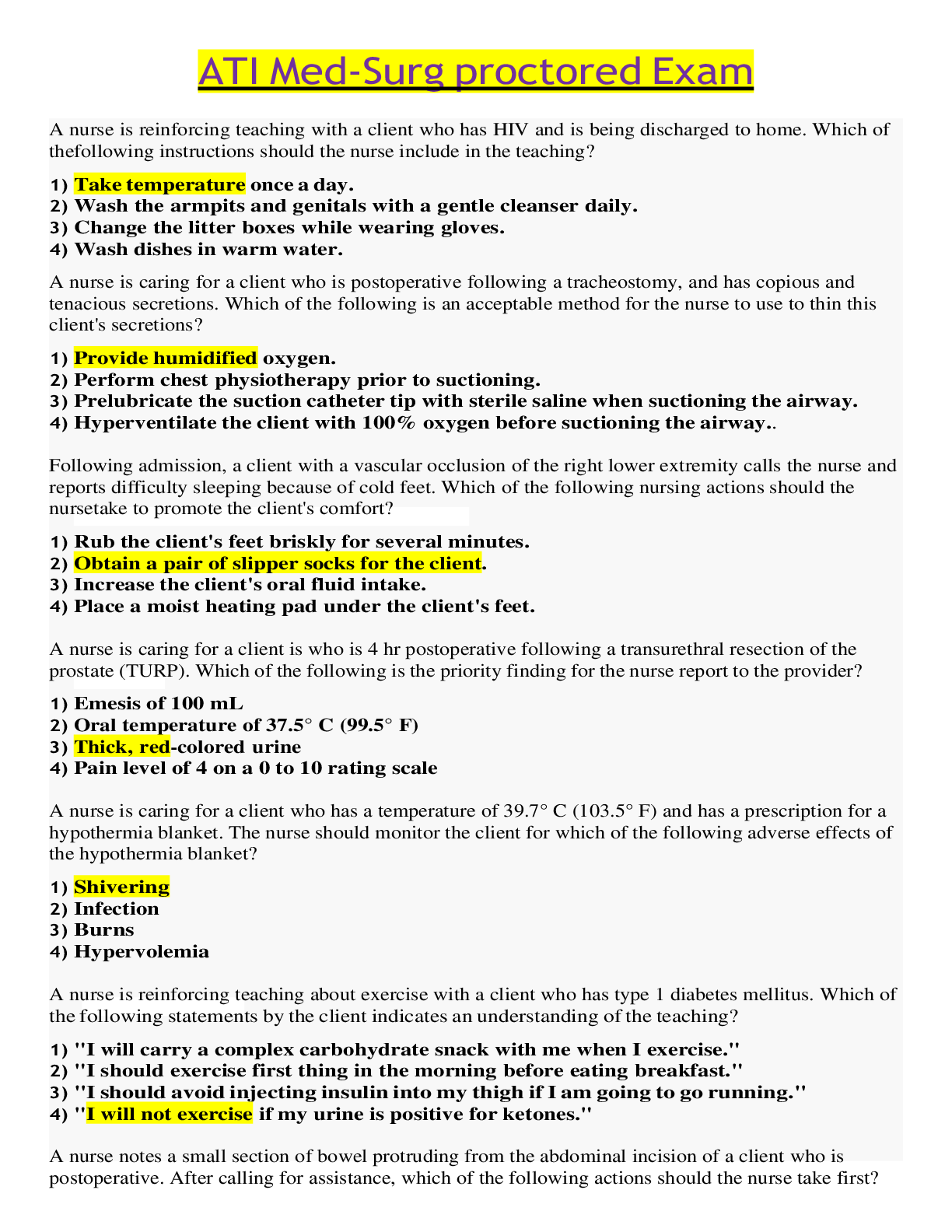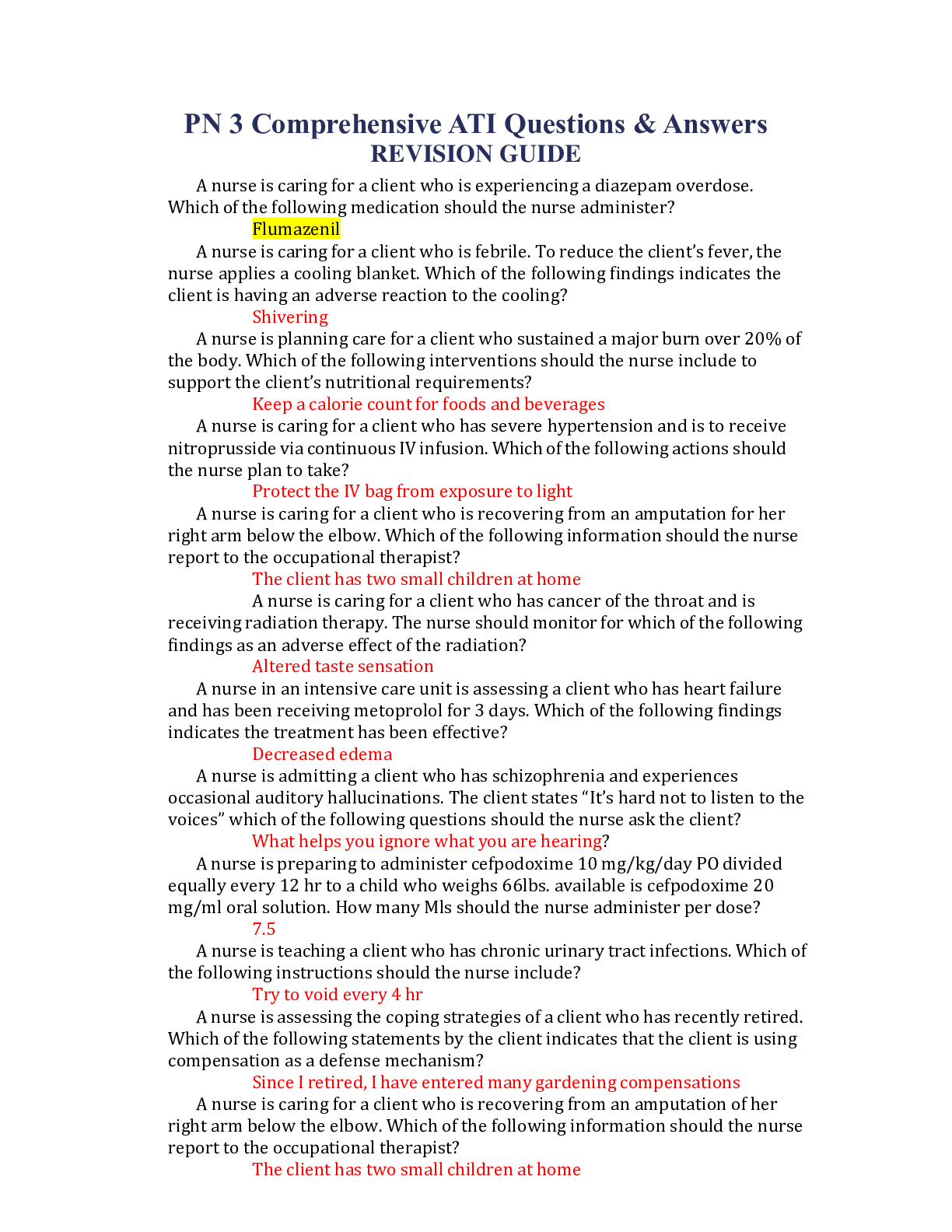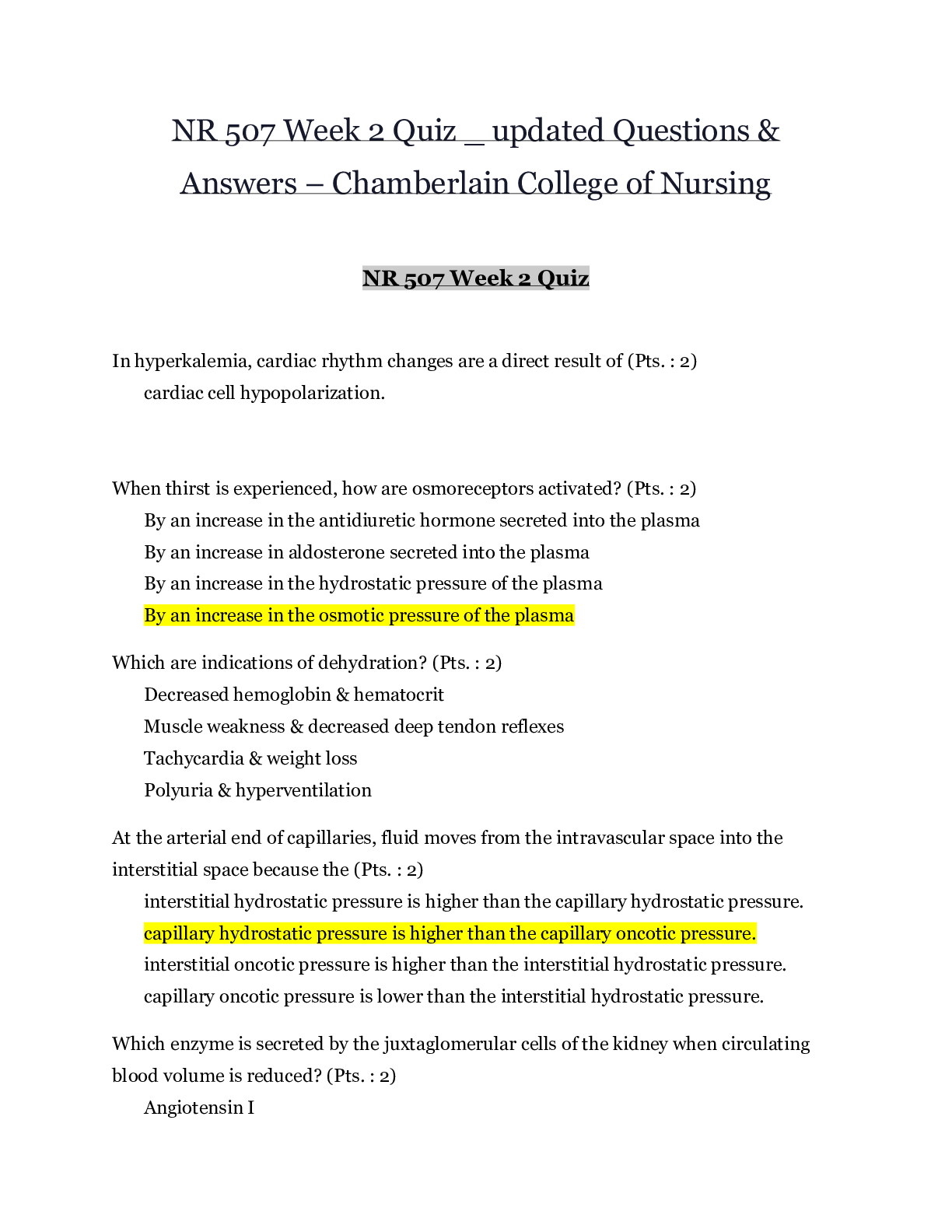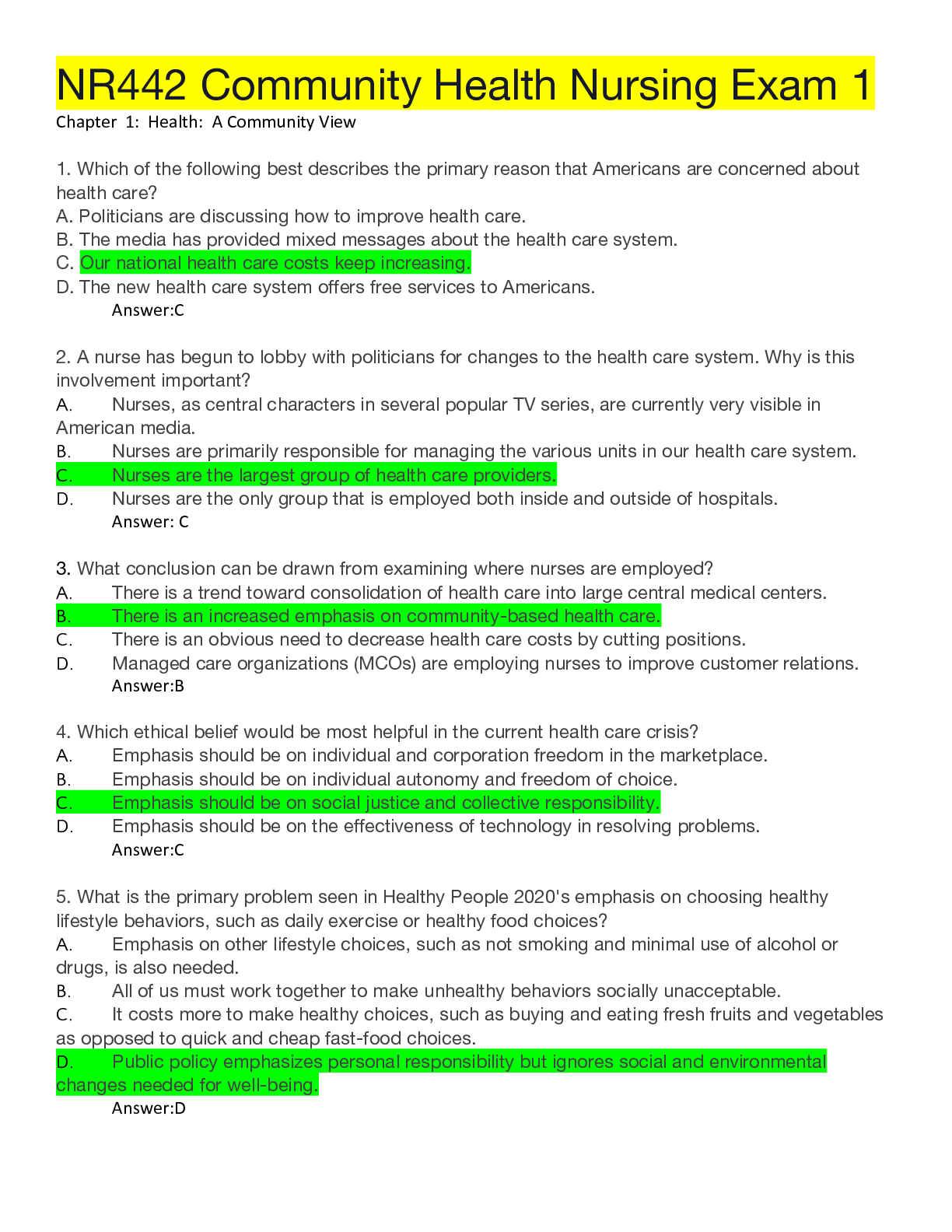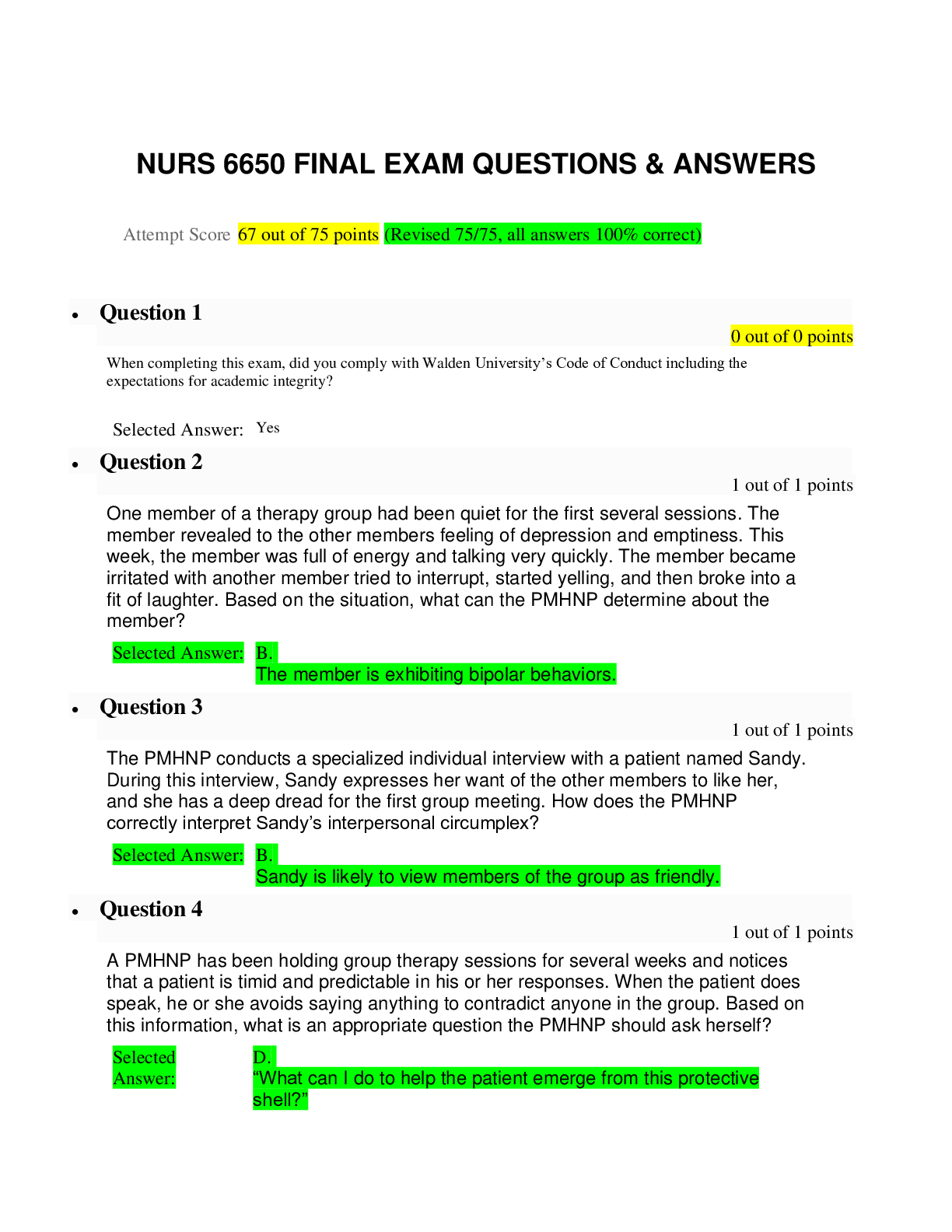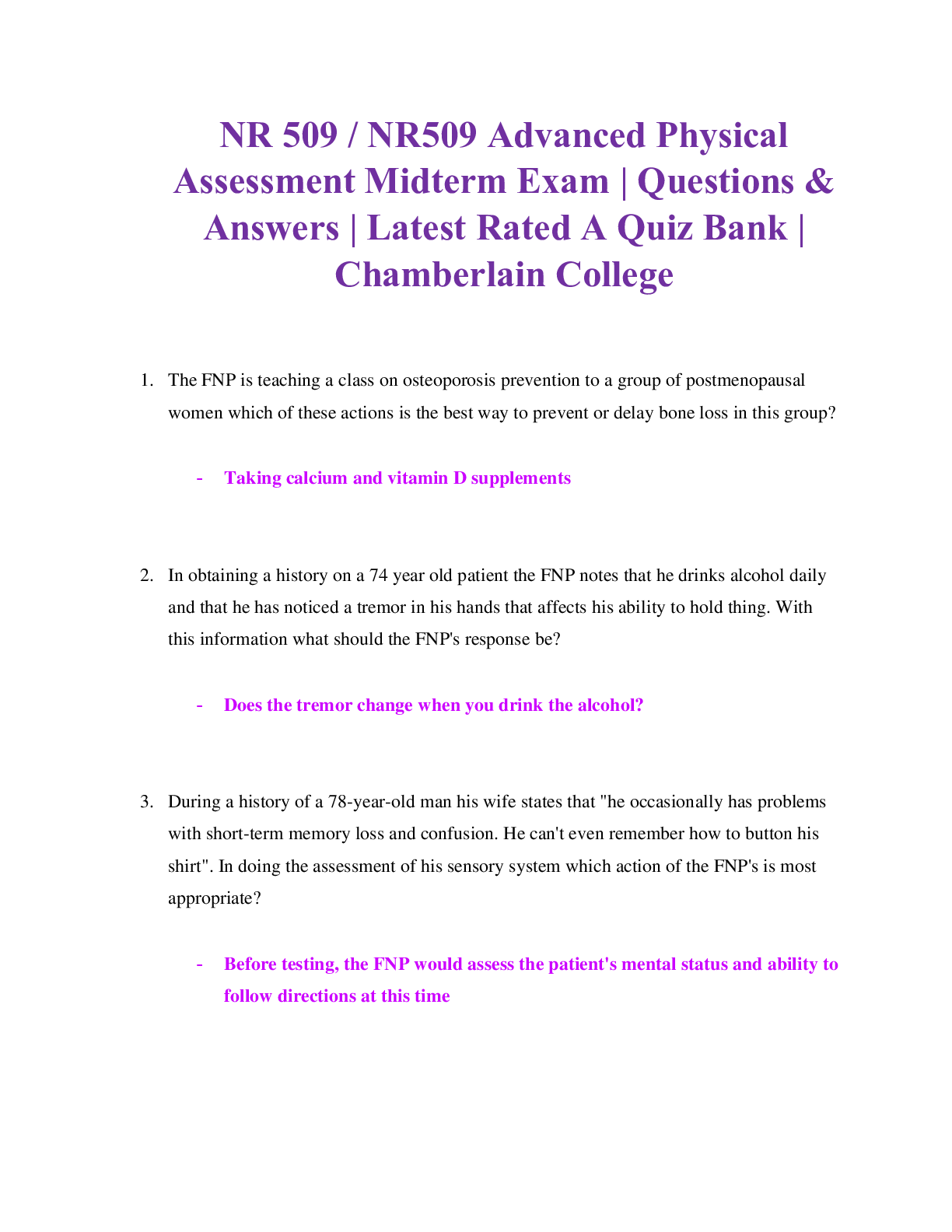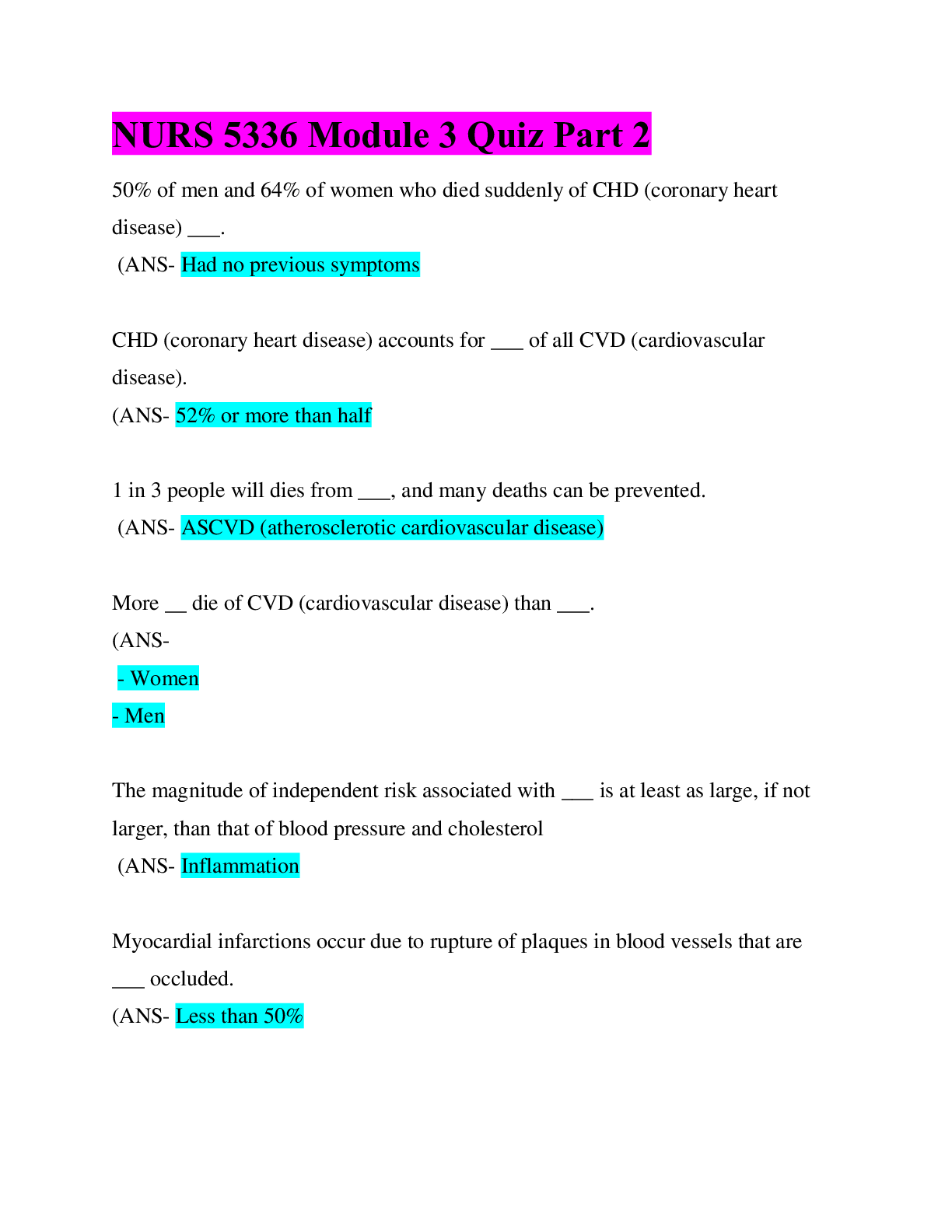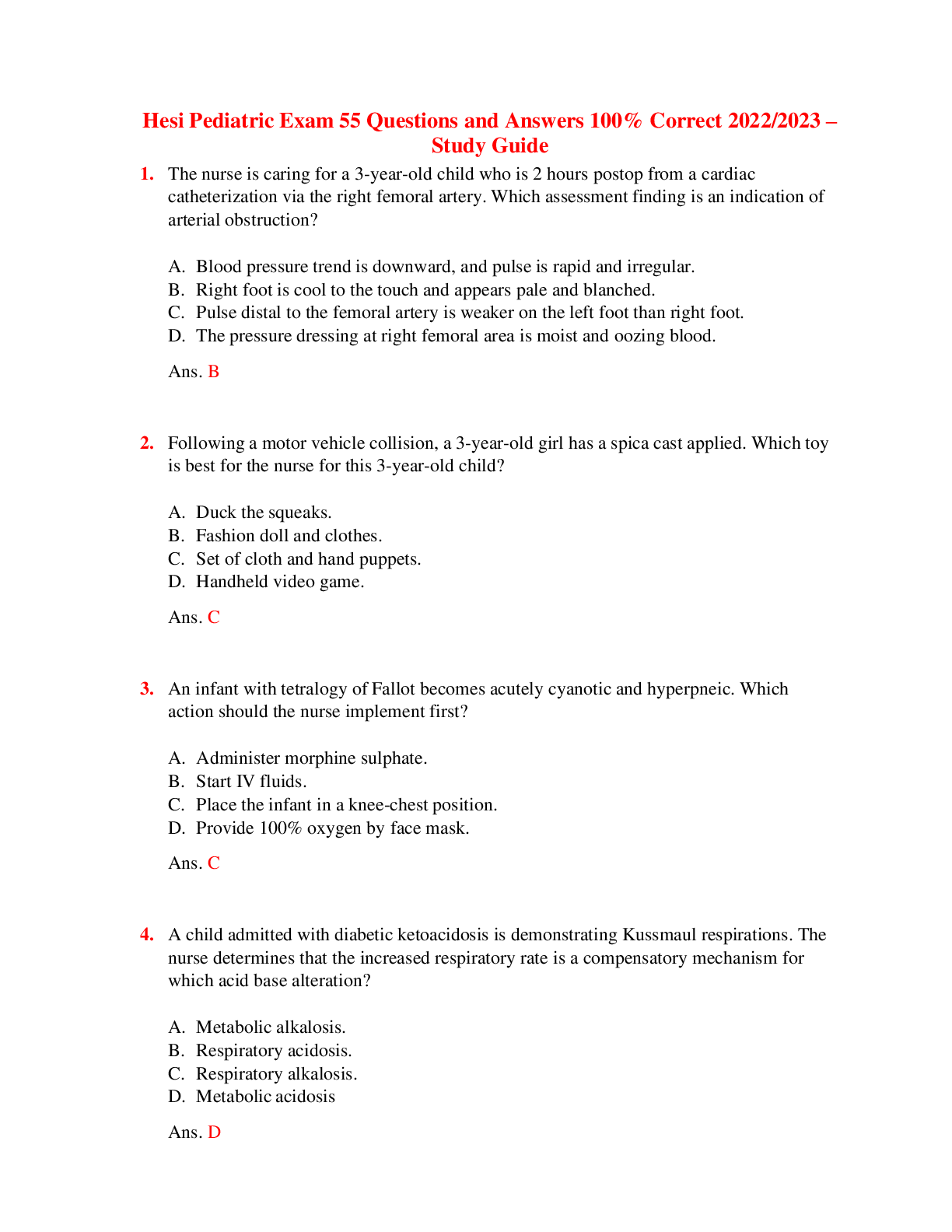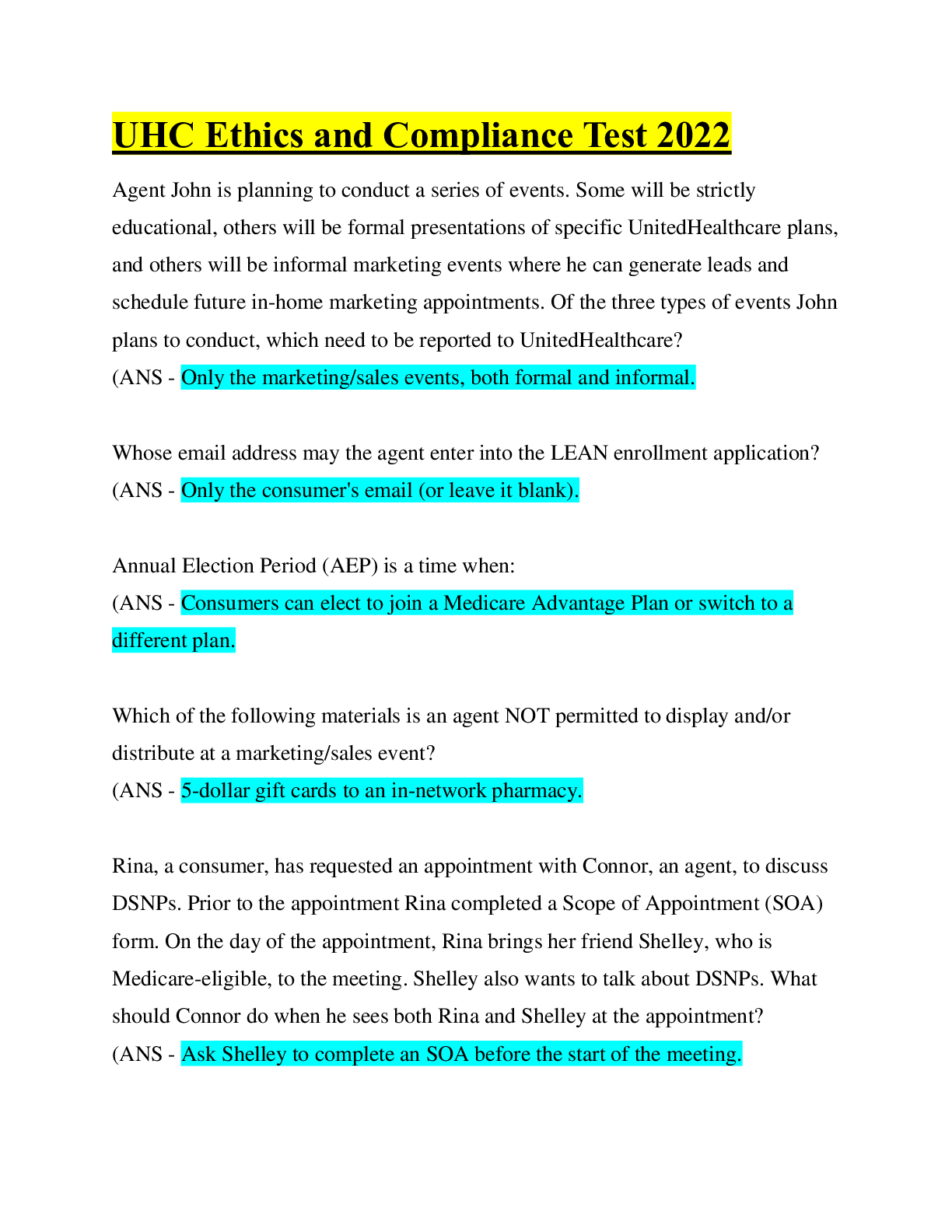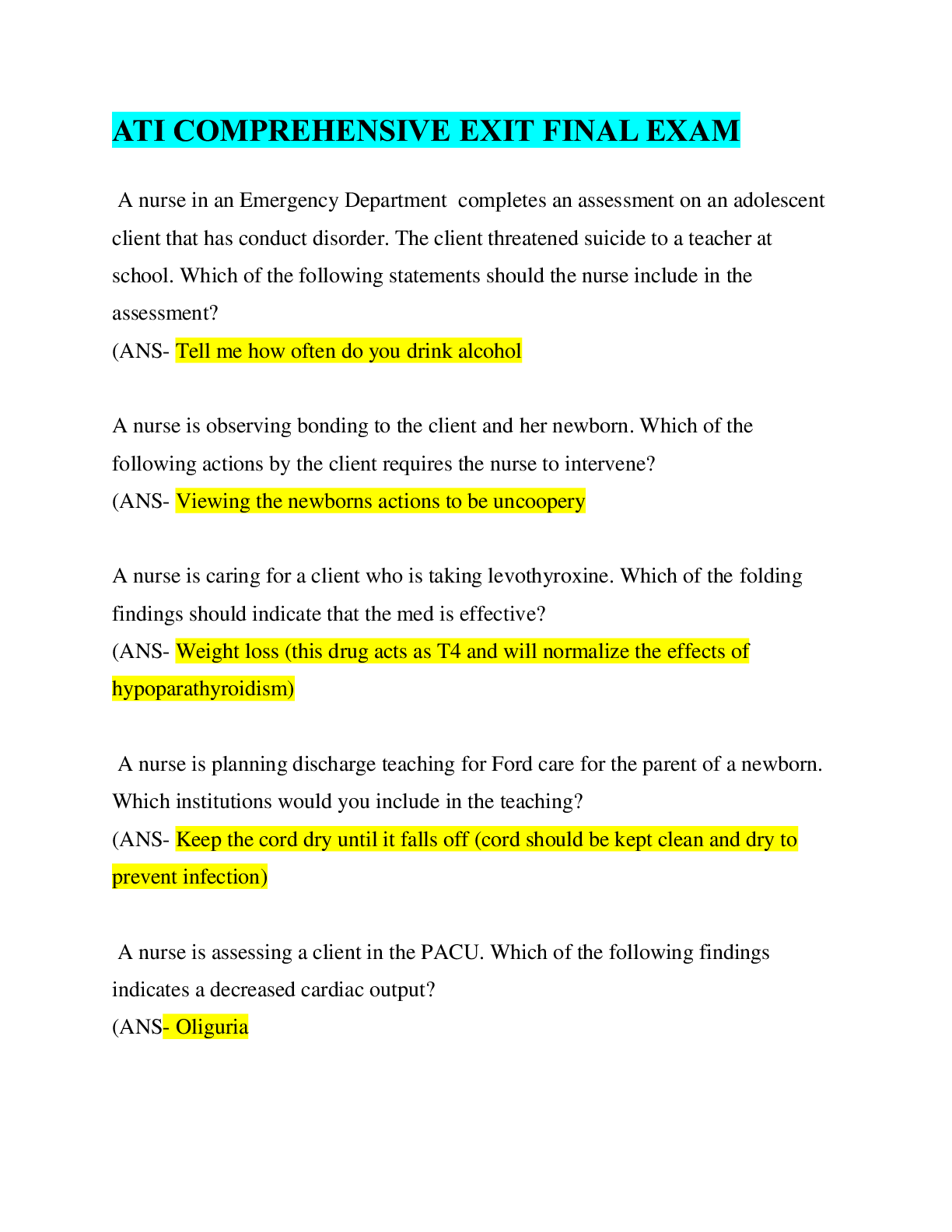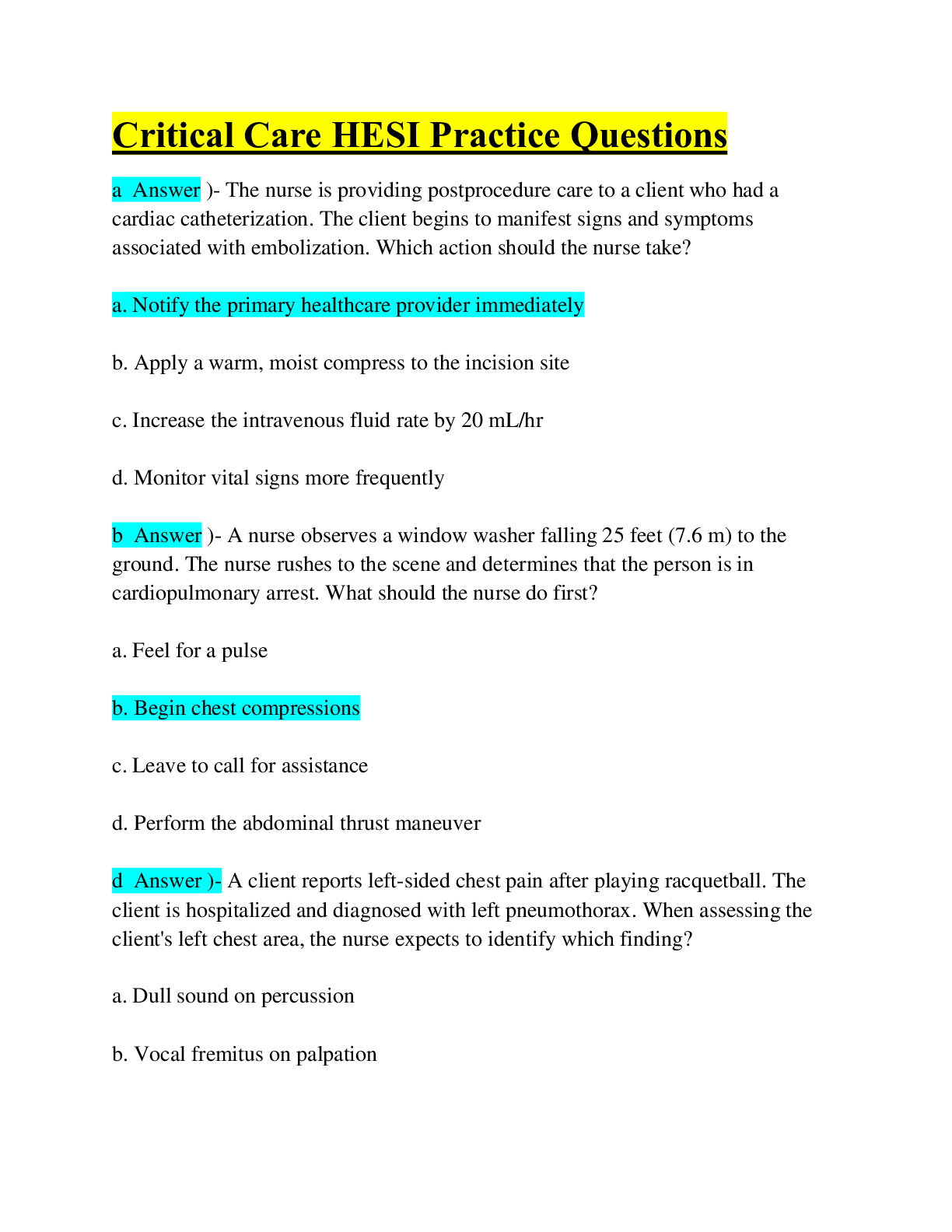MN 553 Unit 1 Quiz Questions & Answers GRADE A
Document Content and Description Below
MN 553 Unit 1 Quiz Questions & Answers Chapter 1. The Role of the Nurse Practitioner Multiple Choice Identify the choice that best completes the statement or answers the question. ____ 1. Nurse practi... tioner prescriptive authority is regulated by: 1. The National Council of State Boards of Nursing 2. The U.S. Drug Enforcement Administration 3. The State Board of Nursing for each state 4. The State Board of Pharmacy ____ 2. The benefits to the patient of having an Advanced Practice Registered Nurse (APRN) prescriber include: 1. Nurses know more about Pharmacology than other prescribers because they take it both in their basic nursing program and in their APRN program. 2. Nurses care for the patient from a holistic approach and include the patient in decision making regarding their care. 3. APRNs are less likely to prescribe narcotics and other controlled substances. 4. APRNs are able to prescribe independently in all states, whereas a physician’s assistant needs to have a physician supervising their practice. ____ 3. Clinical judgment in prescribing includes: 1. Factoring in the cost to the patient of the medication prescribed 2. Always prescribing the newest medication available for the disease process 3. Handing out drug samples to poor patients 4. Prescribing all generic medications to cut costs ____ 4. Criteria for choosing an effective drug for a disorder include: 1. Asking the patient what drug they think would work best for them 2. Consulting nationally recognized guidelines for disease management 3. Prescribing medications that are available as samples before writing a prescription 4. Following U.S. Drug Enforcement Administration guidelines for prescribing ____ 5. Nurse practitioner practice may thrive under health-care reform because of: 1. The demonstrated ability of nurse practitioners to control costs and improve patient outcomes 2. The fact that nurse practitioners will be able to practice independently 3. The fact that nurse practitioners will have full reimbursement under health-care reform 4. The ability to shift accountability for Medicaid to the state level Chapter 2. Review of Basic Principles of Pharmacology Multiple Choice Identify the choice that best completes the statement or answers the question. ____ 1. A patient’s nutritional intake and laboratory results reflect hypoalbuminemia. This is critical to prescribing because: 1. Distribution of drugs to target tissue may be affected. 2. The solubility of the drug will not match the site of absorption. 3. There will be less free drug available to generate an effect. 4. Drugs bound to albumin are readily excreted by the kidneys. ____ 2. Drugs that have a significant first-pass effect: 1. Must be given by the enteral (oral) route only 2. Bypass the hepatic circulation 3. Are rapidly metabolized by the liver and may have little if any desired action 4. Are converted by the liver to more active and fat-soluble forms ____ 3. The route of excretion of a volatile drug will likely be the: 1. Kidneys 2. Lungs 3. Bile and feces 4. Skin ____ 4. Medroxyprogesterone (Depo Provera) is prescribed intramuscularly (IM) to create a storage reservoir of the drug. Storage reservoirs: 1. Assure that the drug will reach its intended target tissue 2. Are the reason for giving loading doses 3. Increase the length of time a drug is available and active 4. Are most common in collagen tissues ____ 5. The NP chooses to give cephalexin every 8 hours based on knowledge of the drug’s: 1. Propensity to go to the target receptor 2. Biological half-life 3. Pharmacodynamics 4. Safety and side effects ____ 6. Azithromycin dosing requires that the first day’s dosage be twice those of the other 4 days of the prescription. This is considered a loading dose. A loading dose: 1. Rapidly achieves drug levels in the therapeutic range 2. Requires four- to five-half-lives to attain 3. Is influenced by renal function 4. Is directly related to the drug circulating to the target tissues ____ 7. The point in time on the drug concentration curve that indicates the first sign of a therapeutic effect is the: 1. Minimum adverse effect level 2. Peak of action 3. Onset of action 4. Therapeutic range ____ 8. Phenytoin requires that a trough level be drawn. Peak and trough levels are done: 1. When the drug has a wide therapeutic range 2. When the drug will be administered for a short time only 3. When there is a high correlation between the dose and saturation of receptor sites 4. To determine if a drug is in the therapeutic range ____ 9. A laboratory result indicates that the peak level for a drug is above the minimum toxic concentration. This means that the: 1. Concentration will produce therapeutic effects 2. Concentration will produce an adverse response 3. Time between doses must be shortened 4. Duration of action of the drug is too long ____ 10. Drugs that are receptor agonists may demonstrate what property? 1. Irreversible binding to the drug receptor site 2. Upregulation with chronic use 3. Desensitization or downregulation with continuous use 4. Inverse relationship between drug concentration and drug action ____ 11. Drugs that are receptor antagonists, such as beta blockers, may cause: 1. Downregulation of the drug receptor 2. An exaggerated response if abruptly discontinued 3. Partial blockade of the effects of agonist drugs 4. An exaggerated response to competitive drug agonists ____ 12. Factors that affect gastric drug absorption include: 1. Liver enzyme activity 2. Protein-binding properties of the drug molecule 3. Lipid solubility of the drug 4. Ability to chew and swallow ____ 13. Drugs administered via IV: 1. Need to be lipid soluble in order to be easily absorbed 2. Begin distribution into the body immediately 3. Are easily absorbed if they are nonionized 4. May use pinocytosis to be absorbed ____ 14. When a medication is added to a regimen for a synergistic effect, the combined effect of the drugs is: 1. The sum of the effects of each drug individually 2. Greater than the sum of the effects of each drug individually 3. Less than the effect of each drug individually 4. Not predictable, as it varies with each individual ____ 15. Which of the following statements about bioavailability is true? 1. Bioavailability issues are especially important for drugs with narrow therapeutic ranges or sustained-release mechanisms. 2. All brands of a drug have the same bioavailability. 3. Drugs that are administered more than once a day have greater bioavailability than drugs given once daily. 4. Combining an active drug with an inert substance does not affect bioavailability. ____ 16. Which of the following statements about the major distribution barriers (blood-brain or fetal-placental) is true? 1. Water soluble and ionized drugs cross these barriers rapidly. 2. The blood-brain barrier slows the entry of many drugs into and from brain cells. 3. The fetal-placental barrier protects the fetus from drugs taken by the mother. 4. Lipid-soluble drugs do not pass these barriers and are safe for pregnant women. ____ 17. Drugs are metabolized mainly by the liver via phase I or phase II reactions. The purpose of both of these types of reactions is to: 1. Inactivate prodrugs before they can be activated by target tissues 2. Change the drugs so they can cross plasma membranes 3. Change drug molecules to a form that an excretory organ can excrete 4. Make these drugs more ionized and polar to facilitate excretion ____ 18. Once they have been metabolized by the liver, the metabolites may be: 1. More active than the parent drug 2. Less active than the parent drug 3. Totally “deactivated” so they are excreted without any effect 4. All of the above ____ 19. All drugs continue to act in the body until they are changed or excreted. The ability of the body to excrete drugs via the renal system would be increased by: 1. Reduced circulation and perfusion of the kidney 2. Chronic renal disease 3. Competition for a transport site by another drug 4. Unbinding a nonvolatile drug from plasma proteins ____ 20. Steady state is: 1. The point on the drug concentration curve when absorption exceeds excretion 2. When the amount of drug in the body remains constant 3. When the amount of drug in the body stays below the minimum toxic concentration 4. All of the above ____ 21. Two different pain medications are given together for pain relief. The drug—drug interaction is: 1. Synergistic 2. Antagonistic 3. Potentiative 4. Additive ____ 22. Actions taken to reduce drug—drug interaction problems include all of the following EXCEPT: 1. Reducing the dosage of one of the drugs 2. Scheduling their administration at different times 3. Prescribing a third drug to counteract the adverse reaction of the combination 4. Reducing the dosage of both drugs ____ 23. Phase I oxidative-reductive processes of drug metabolism require certain nutritional elements. Which of the following would reduce or inhibit this process? 1. Protein malnutrition 2. Iron-deficiency anemia 3. Both 1 and 2 4. Neither 1 nor 2 ____ 24. The time required for the amount of drug in the body to decrease by 50% is called: 1. Steady state 2. Half-life 3. Phase II metabolism 4. Reduced bioavailability time ____ 25. An agonist activates a receptor and stimulates a response. When given frequently over time, the body may: 1. Upregulate the total number of receptors 2. Block the receptor with a partial agonist 3. Alter the drug’s metabolism 4. Downregulate the numbers of that specific receptor ____ 26. Drug antagonism is best defined as an effect of a drug that: 1. Leads to major physiological and psychological dependence 2. Is modified by the concurrent administration of another drug 3. Cannot be metabolized before another dose is administered 4. Leads to a decreased physiological response when combined with another drug ____ 27. Instructions to a client regarding self-administration of oral enteric-coated tablets should include which of the following statements? 1. “Avoid any other oral medicines while taking this drug.” 2. “If swallowing this tablet is difficult, dissolve it in 3 ounces of orange juice.” 3. “The tablet may be crushed if you have any difficulty taking it.” 4. “To achieve best effect, take the tablet with at least 8 ounces of fluid.” ____ 28. The major reason for not crushing a sustained-release capsule is that, if crushed, the coated beads of the drugs could possibly result in: 1. Disintegration 2. Toxicity 3. Malabsorption 4. Deterioration ____ 29. Which of the following substances is the most likely to be absorbed in the intestines rather than in the stomach? 1. Sodium bicarbonate 2. Ascorbic acid 3. Salicylic acid 4. Glucose ____ 30. Which of the following variables is a factor in drug absorption? 1. The smaller the surface area for absorption, the more rapidly the drug is absorbed. 2. A rich blood supply to the area of absorption leads to better absorption. 3. The less soluble the drug, the more easily it is absorbed. 4. Ionized drugs are easily absorbed across the cell membrane. ____ 31. An advantage of prescribing a sublingual medication is that the medication is: 1. Absorbed rapidly 2. Excreted rapidly 3. Metabolized minimally 4. Distributed equally ____ 32. Drugs that use CYP 3A4 isoenzymes for metabolism may: 1. Induce the metabolism of another drug 2. Inhibit the metabolism of another drug 3. Both 1 and 2 4. Neither 1 nor 2 ____ 33. Therapeutic drug levels are drawn when a drug reaches steady state. Drugs reach steady state: 1. After the second dose 2. After four to five half-lives 3. When the patient feels the full effect of the drug 4. One hour after IV administration ____ 34. Upregulation or hypersensitization may lead to: 1. Increased response to a drug 2. Decreased response to a drug 3. An exaggerated response if the drug is withdrawn 4. Refractoriness or complete lack of response Chapter 3. Rational Drug Selection Multiple Choice Identify the choice that best completes the statement or answers the question. ____ 1. An NP would prescribe the liquid form of ibuprofen for a 6-year-old child because: 1. Drugs given in liquid form are less irritating to the stomach. 2. A 6-year-old child may have problems swallowing a pill. 3. Liquid forms of medication eliminate the concern for first-pass effect. 4. Liquid ibuprofen does not have to be dosed as often as the tablet form. ____ 2. In deciding which of multiple drugs used to use to treat a condition, the NP chooses Drug A because it: 1. Has serious side effects and it is not being used for a life-threatening condition 2. Will be taken twice daily and will be taken at home 3. Is expensive, but covered by health insurance 4. None of these are important in choosing a drug ____ 3. A client asks the NP about the differences in drug effects between men and women. What is known about the differences between the pharmacokinetics of men and women? 1. Body temperature varies between men and women. 2. Muscle mass is greater in women. 3. Percentage of fat differs between genders. 4. Proven subjective factors exist between the genders. ____ 4. The first step in the prescribing process according to the World Health Organization is: 1. Choosing the treatment 2. Educating the patient about the medication 3. Diagnosing the patient’s problem 4. Starting the treatment ____ 5. Treatment goals in prescribing should: 1. Always be curative 2. Be patient-centered 3. Be convenient for the provider 4. Focus on the cost of therapy ____ 6. The therapeutic goals when prescribing include(s): 1. Curative 2. Palliative 3. Preventive 4. All of the above ____ 7. When determining drug treatment the NP prescriber should: 1. Always use evidence-based guidelines 2. Individualize the drug choice for the specific patient 3. Rely on his or her experience when prescribing for complex patients 4. Use the newest drug on the market for the condition being treated ____ 8. Patient education regarding prescribed medication includes: 1. Instructions written at the high school reading level 2. Discussion of expected adverse drug reactions 3. How to store leftover medication such as antibiotics 4. Verbal instructions always in English ____ 9. Passive monitoring of drug effectiveness includes: 1. Therapeutic drug levels 2. Adding or subtracting medications from the treatment regimen 3. Ongoing provider visits 4. Instructing the patient to report if the drug is not effective ____ 10. Pharmacokinetic factors that affect prescribing include: 1. Therapeutic index 2. Minimum effective concentration 3. Bioavailability 4. Ease of titration ____ 11. Pharmaceutical promotion may affect prescribing. To address the impact of pharmaceutical promotion, the following recommendations have been made by the Institute of Medicine: 1. Conflicts of interest and financial relationships should be disclosed by those providing education. 2. Providers should ban all pharmaceutical representatives from their office setting. 3. Drug samples should be used for patients who have the insurance to pay for them, to ensure the patient can afford the medication. 4. Providers should only accept low-value gifts, such as pens and pads of paper, from the pharmaceutical representative. ____ 12. Under new U.S. Food and Drug Administration labeling, Pregnancy Categories will be: 1. Strengthened with a new coding such as C or C- to discern when a drug is more or less toxic to the fetus 2. Changed to incorporate a pregnancy risk summary and clinical considerations on the drug label 3. Eliminated, and replaced with a link to the National Library of Medicine TOXNET Web site for in-depth information regarding pregnancy concerns 4. Clarified to include information such as safe dosages in each trimester of pregnancy Chapter 4. Legal and Professional Issues in Prescribing Multiple Choice Identify the choice that best completes the statement or answers the question. ____ 1. The U.S. Food and Drug Administration regulates: 1. Prescribing of drugs by MDs and NPs 2. The official labeling for all prescription and over-the-counter drugs 3. Off-label recommendations for prescribing 4. Pharmaceutical educational offerings ____ 2. The U.S. Food and Drug Administration approval is required for: 1. Medical devices, including artificial joints 2. Over-the-counter vitamins 3. Herbal products, such as St John’s wort 4. Dietary supplements, such as Ensure ____ 3. An Investigational New Drug is filed with the U.S. Food and Drug Administration: 1. When the manufacturer has completed phase III trials 2. When a new drug is discovered 3. Prior to animal testing of any new drug entity 4. Prior to human testing of any new drug entity ____ 4. Phase IV clinical trials in the United States are also known as: 1. Human bioavailability trials 2. Postmarketing research 3. Human safety and efficacy studies 4. The last stage of animal trials before the human trials begin ____ 5. Off-label prescribing is: 1. Regulated by the U.S. Food and Drug Administration 2. Illegal by NPs in all states (provinces) 3. Legal if there is scientific evidence for the use 4. Regulated by the Drug Enforcement Administration ____ 6. The U.S. Drug Enforcement Administration: 1. Registers manufacturers and prescribers of controlled substances 2. Regulates NP prescribing at the state level 3. Sanctions providers who prescribe drugs off-label 4. Provides prescribers with a number they can use for insurance billing ____ 7. Drugs that are designated Schedule II by the U.S. Drug Enforcement Administration: 1. Are known teratogens during pregnancy 2. May not be refilled; a new prescription must be written 3. Have a low abuse potential 4. May be dispensed without a prescription unless regulated by the state ____ 8. Precautions that should be taken when prescribing controlled substances include: 1. Faxing the prescription for a Schedule II drug directly to the pharmacy 2. Using tamper-proof paper for all prescriptions written for controlled drugs 3. Keeping any pre-signed prescription pads in a locked drawer in the clinic 4. Using only numbers to indicate the amount of drug to be prescribed ____ 9. Strategies prescribers can use to prevent misuse of controlled prescription drugs include: 1. Use of chemical dependency screening tools 2. Firm limit-setting regarding prescribing controlled substances 3. Practicing “just say no” to deal with patients who are pushing the provider to prescribe controlled substances 4. All of the above ____ 10. Behaviors predictive of addiction to controlled substances include: 1. Stealing or borrowing another patient’s drugs 2. Requiring increasing doses of opiates for pain associated with malignancy 3. Receiving refills of a Schedule II prescription on a regular basis 4. Requesting that only their own primary care provider prescribe for them ____ 11. Medication agreements or “Pain Medication Contracts” are recommended to be used: 1. Universally for all prescribing for chronic pain 2. For patients who have repeated requests for pain medication 3. When you suspect a patient is exhibiting drug-seeking behavior 4. For patients with pain associated with malignancy ____ 12. A prescription needs to be written for: 1. Legend drugs 2. Most controlled drugs 3. Medical devices 4. All of the above Chapter 6. Factors That Foster Positive Outcomes Multiple Choice Identify the choice that best completes the statement or answers the question. ____ 1. A comprehensive assessment of a patient should be holistic when trying to determine competence in drug administration. Which of the following factors would the NP omit from this type of assessment? 1. Financial status 2. Mobility 3. Social support 4. Sexual practices ____ 2. Elena Vasquez’s primary language is Spanish, and she speaks very limited English. Which technique would be appropriate to use in teaching her about a new drug you have just prescribed? 1. Use correct medical terminology because Spanish has a Latin base. 2. Use a family member who speaks more English to act as an interpreter. 3. Use a professional interpreter or a reliable staff member who can act as an interpreter. 4. Use careful, detailed explanations. ____ 3. Rod, age 68, has hearing difficulty. Which of the following would NOT be helpful in assuring that he understands teaching about his drug? 1. Stand facing him and speak slowly and clearly. 2. Speak in low tones or find a provider who has a lower voice. 3. Write down the instructions as well as speaking them. 4. If he reads lips, exaggerate lips movements when pronouncing the vowel sounds. ____ 4. Which of the following factors may adversely affect a patient’s adherence to a therapeutic drug regimen? 1. Complexity of the drug regimen 2. Patient perception of the potential adverse effects of the drugs 3. Both 1 and 2 4. Neither 1 nor 2 ____ 5. The health-care delivery system itself can create barriers to adherence to a treatment regimen. Which of the following system variables creates such a barrier? 1. Increasing copayments for care 2. Unrestricted formularies for drugs, including brand names 3. Increasing the number of people who have access to care 4. Treating a wider range of disorders ____ 6. Ralph’s blood pressure remains elevated despite increased doses of his drug. The NP is concerned that he might not be adhering to his treatment regimen. Which of the following events would suggest that he might not be adherent? 1. Ralph states that he always takes the drug “when I feel my pressure is going up.” 2. Ralph contacts his NP to discuss the need to increase the dosage. 3. Ralph consistently keeps his follow-up appointments to check his blood pressure. 4. All of the above show that he is adherent to the drug regimen. ____ 7. Nonadherence is especially common in drugs that treat asymptomatic conditions, such as hypertension. One way to reduce the likelihood of nonadherence to these drugs is to prescribe a drug that: 1. Has a short half-life so that missing one dose has limited effect 2. Requires several dosage titrations so that missed doses can be replaced with lower doses to keep costs down 3. Has a tolerability profile with fewer of the adverse effects that are considered “irritating,” such as nausea and dizziness 4. Must be taken no more than twice a day ____ 8. Factors in chronic conditions that contribute to nonadherence include: 1. The complexity of the treatment regimen 2. The length of time over which it must be taken 3. Breaks in the usual daily routine, such as vacations and weekends 4. All of the above ____ 9. While patient education about their drugs is important, information alone does not necessarily lead to adherence to a drug regimen. Patients report greater adherence when: 1. The provider spent a lot of time discussing the drugs with them 2. Their concerns and specific area of knowledge deficit were addressed 3. They were given written material, such as pamphlets, about the drugs 4. The provider used appropriate medical and pharmacological terms ____ 10. Patients with psychiatric illnesses have adherence rates to their drug regimen between 35% and 60%. To improve adherence in this population, prescribe drugs: 1. With a longer half-life so that missed doses produce a longer taper on the drug curve 2. In oral formulations that are more easily taken 3. That do not require frequent monitoring 4. Combined with patient education about the need to adhere even when symptoms are absent ____ 11. Many disorders require multiple drugs to treat them. The more complex the drug regimen, the less likely the patient will adhere to it. Which of the following interventions will NOT improve adherence? 1. Have the patient purchase a pill container with compartments for daily or multiple times-per-day dosing. 2. Match the clinic appointment to the next time the drug is to be refilled. 3. Write prescriptions for new drugs with shorter times between refills. 4. Give the patient a clear drug schedule that the provider devises to fit the characteristic of the drug. ____ 12. Pharmacologic interventions are costly. Patients for whom the cost/benefit variable is especially important include: 1. Older adults and those on fixed incomes 2. Patients with chronic illnesses 3. Patients with copayments for drugs on their insurance 4. Patients on public assistance ____ 13. Providers have a responsibility for determining the best plan of care, but patients also have responsibilities. Patients the provider can be assured will carry through on these responsibilities include those who: 1. Are well-educated and affluent 2. Have chronic conditions 3. Self-monitor drug effects on their symptoms 4. None of the above guarantee adherence ____ 14. Monitoring adherence can take several forms, including: 1. Patient reports from data in a drug diary 2. Pill counts 3. Laboratory reports and other diagnostic markers 4. All of the [Show More]
Last updated: 1 year ago
Preview 1 out of 139 pages
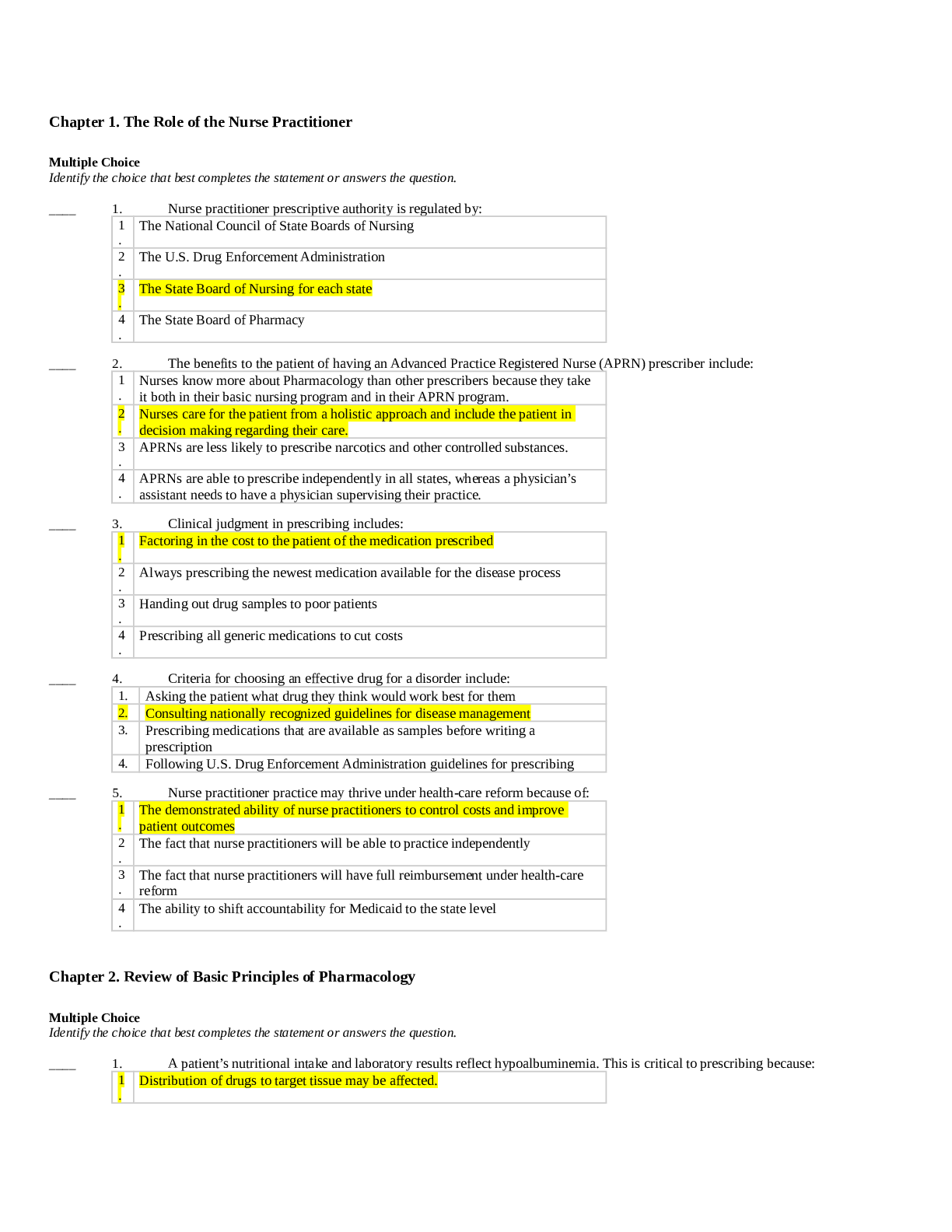
Reviews( 0 )
Document information
Connected school, study & course
About the document
Uploaded On
Sep 13, 2021
Number of pages
139
Written in
Additional information
This document has been written for:
Uploaded
Sep 13, 2021
Downloads
0
Views
51

 (1).png)
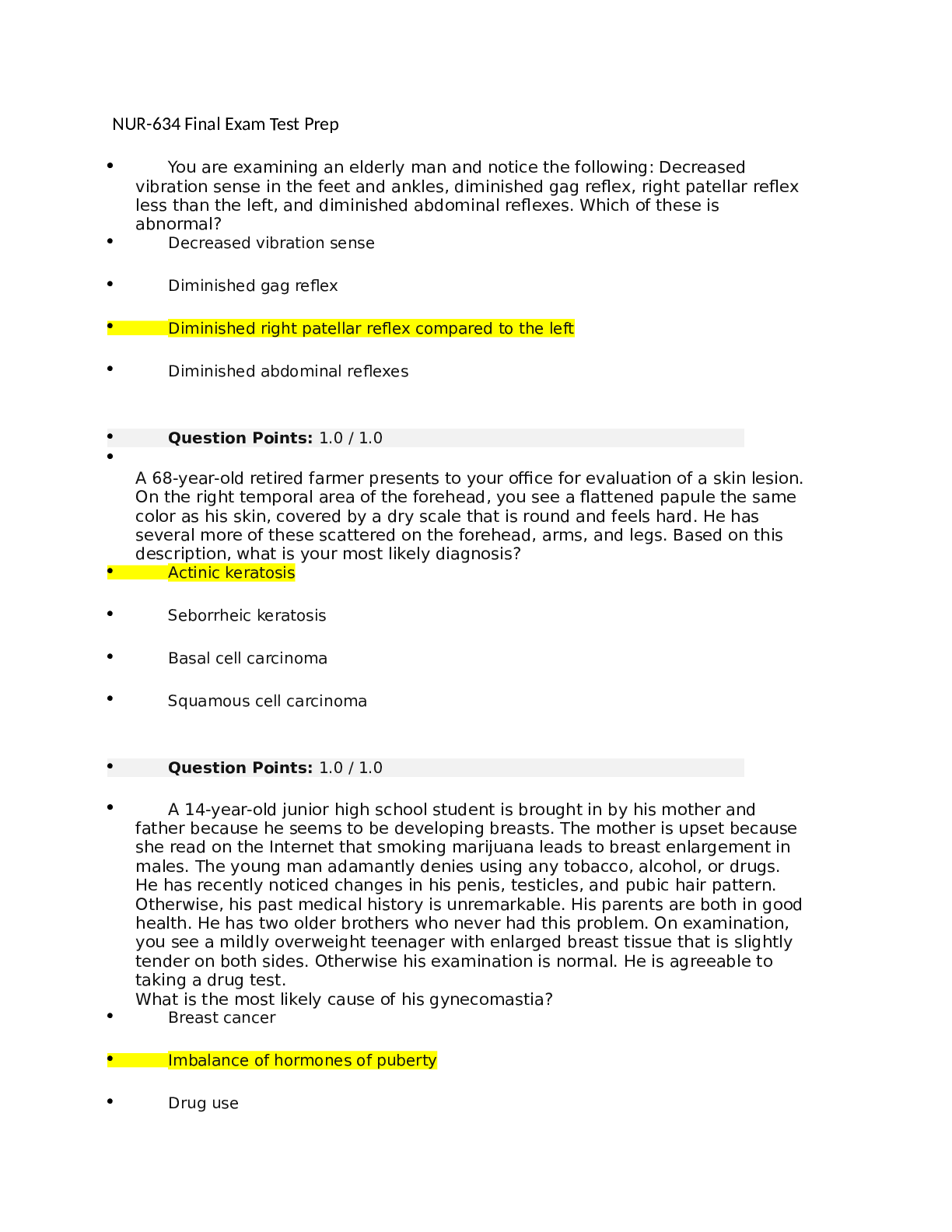

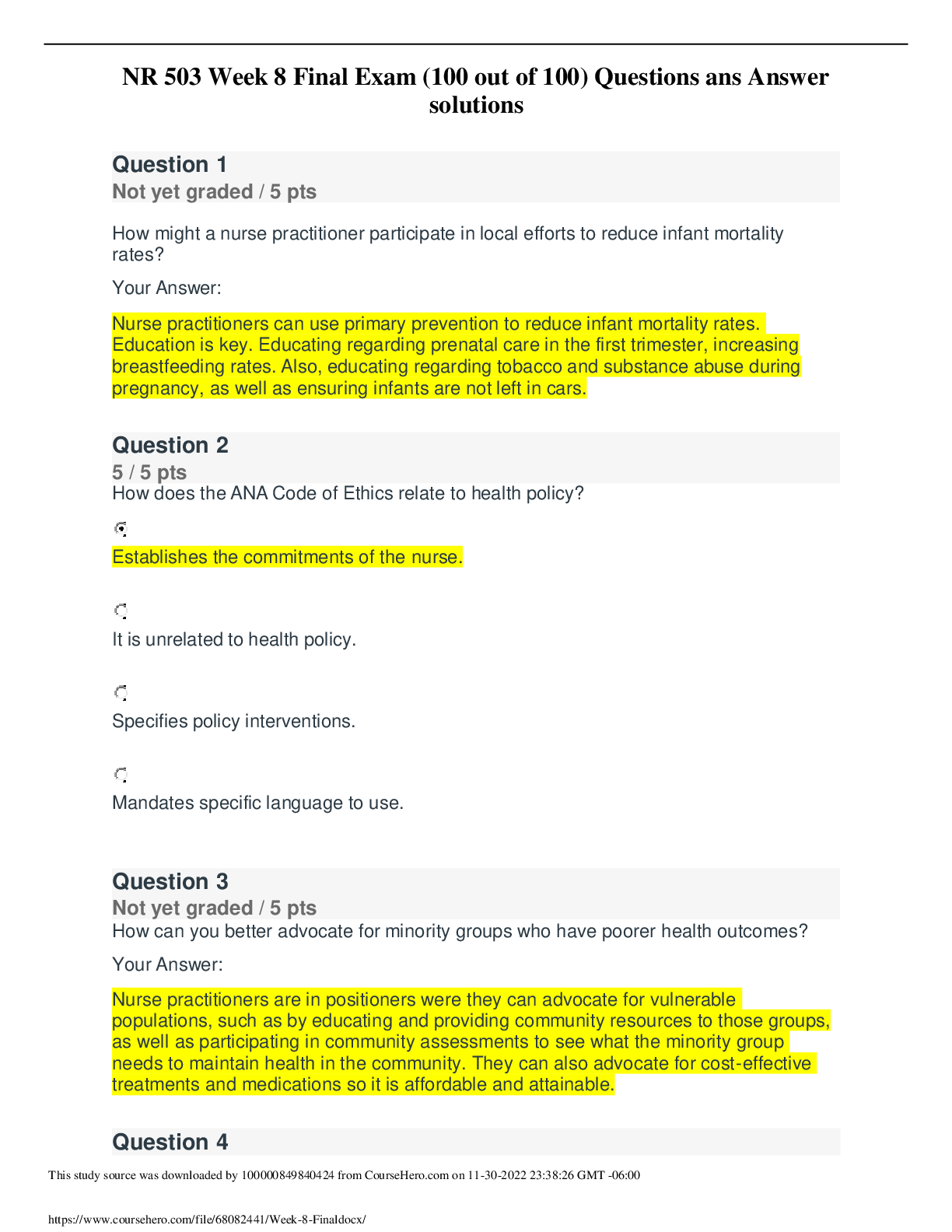
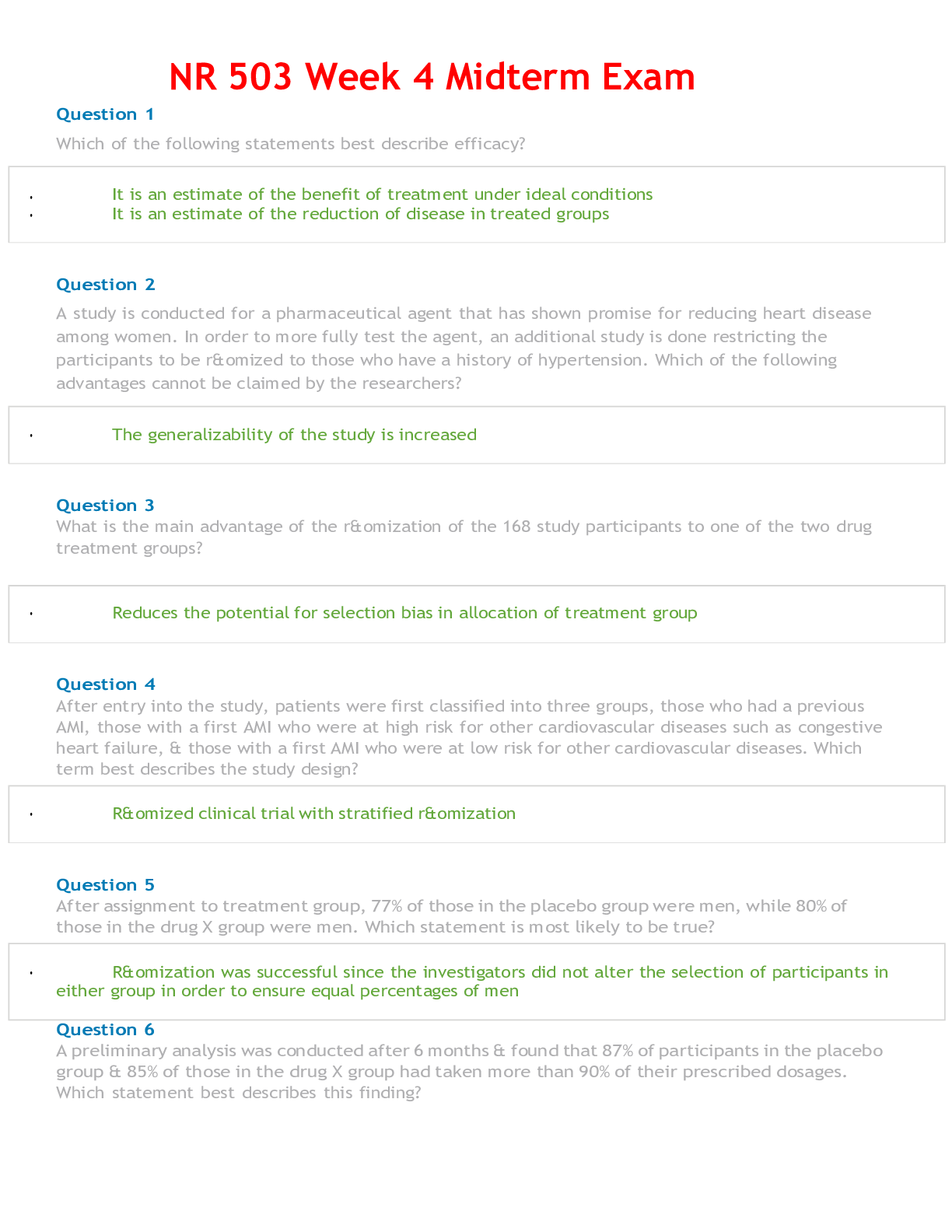
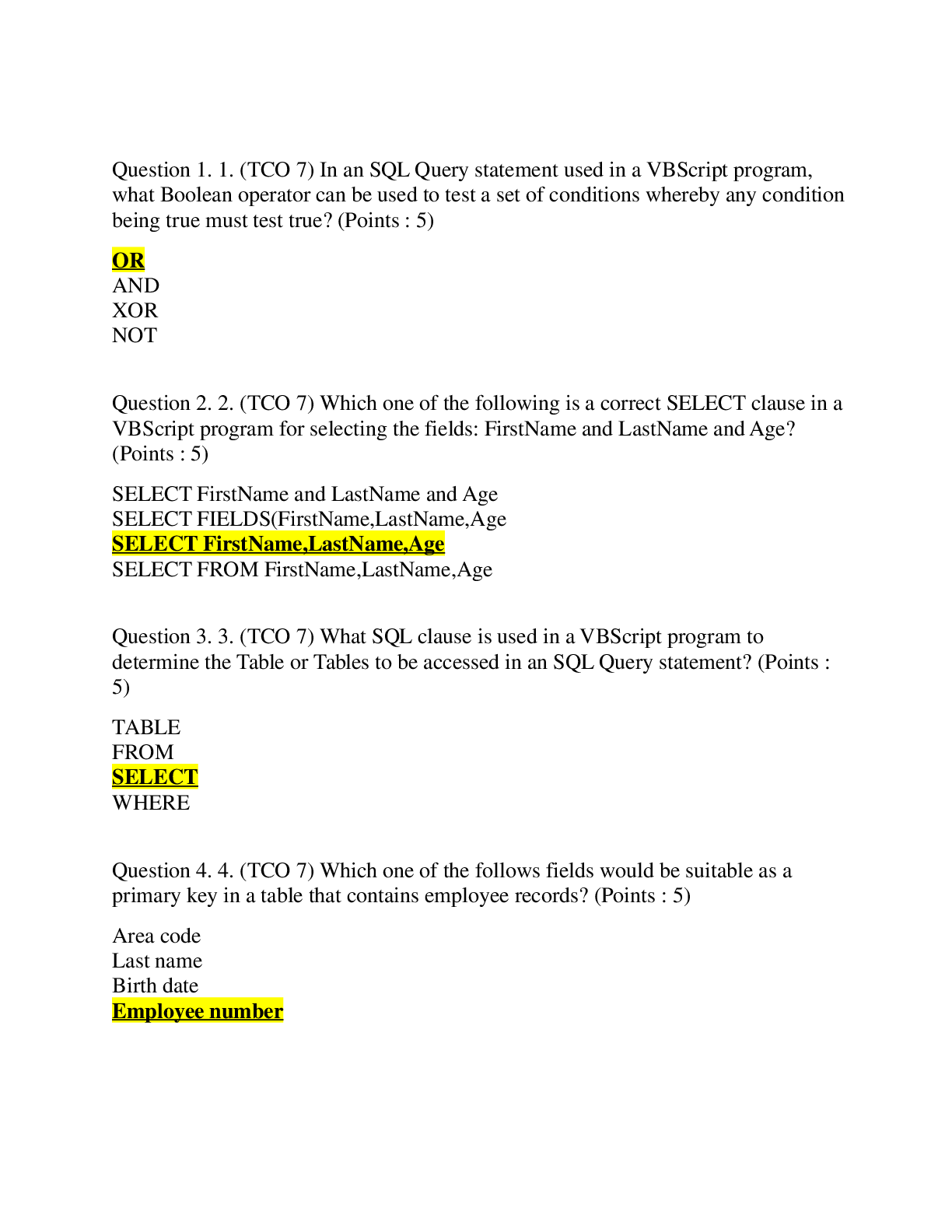
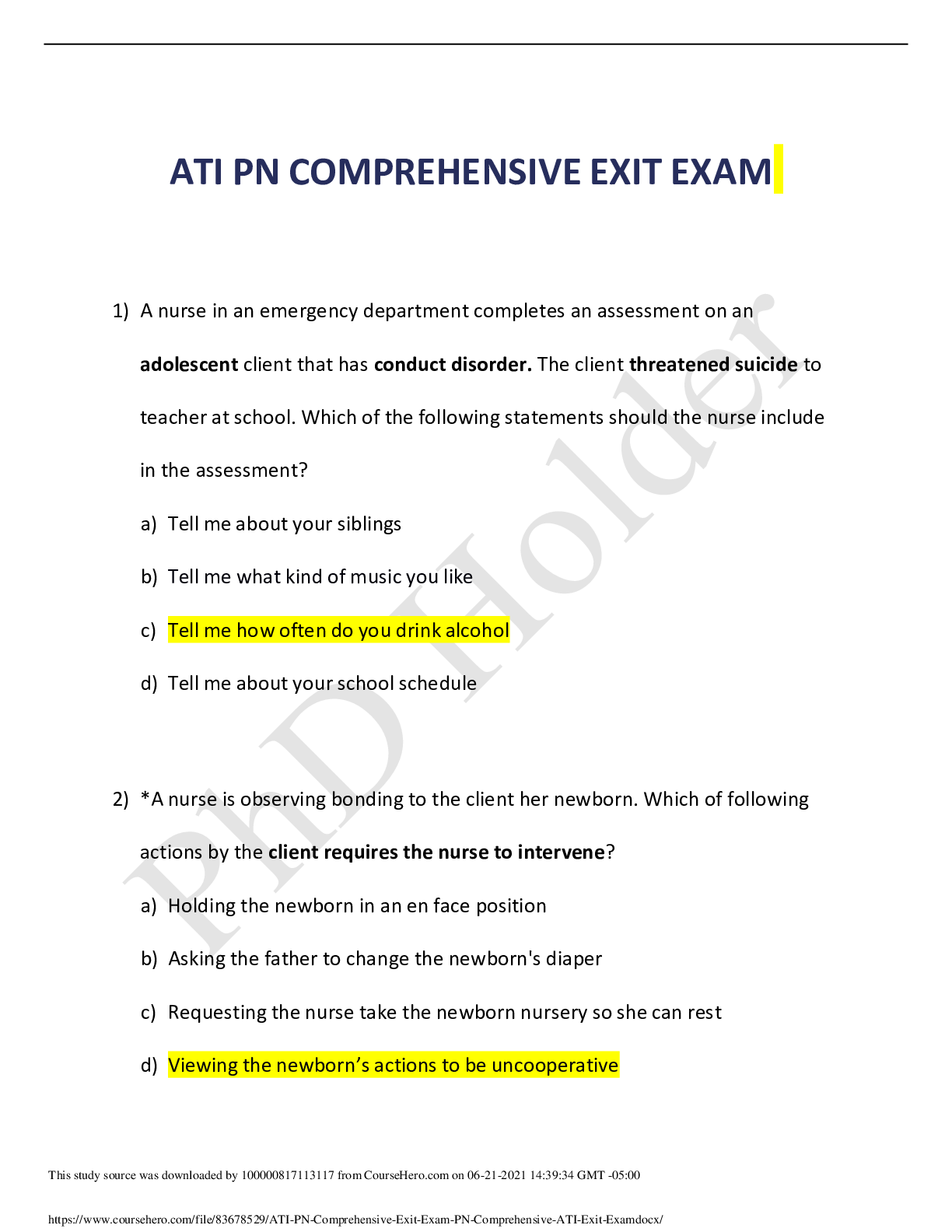
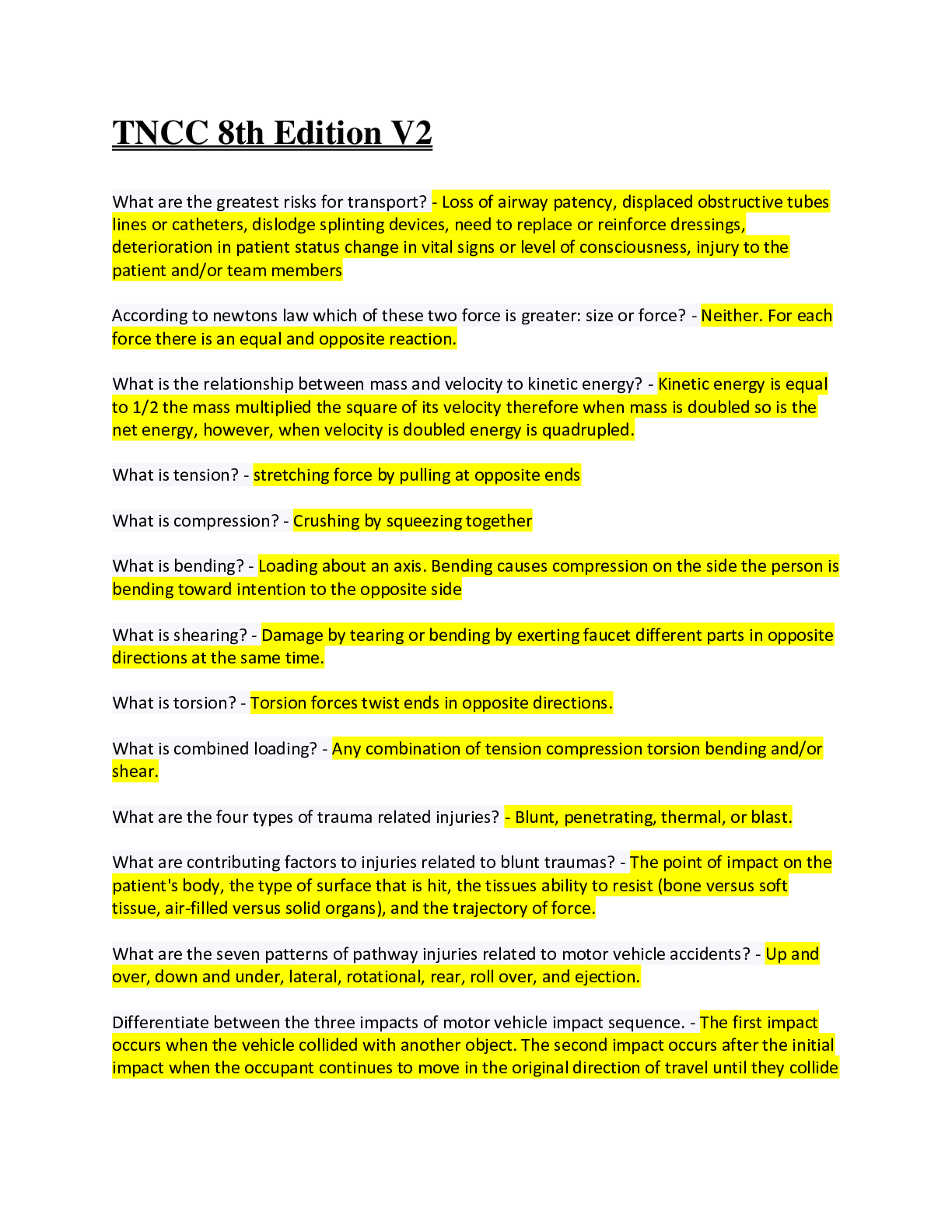
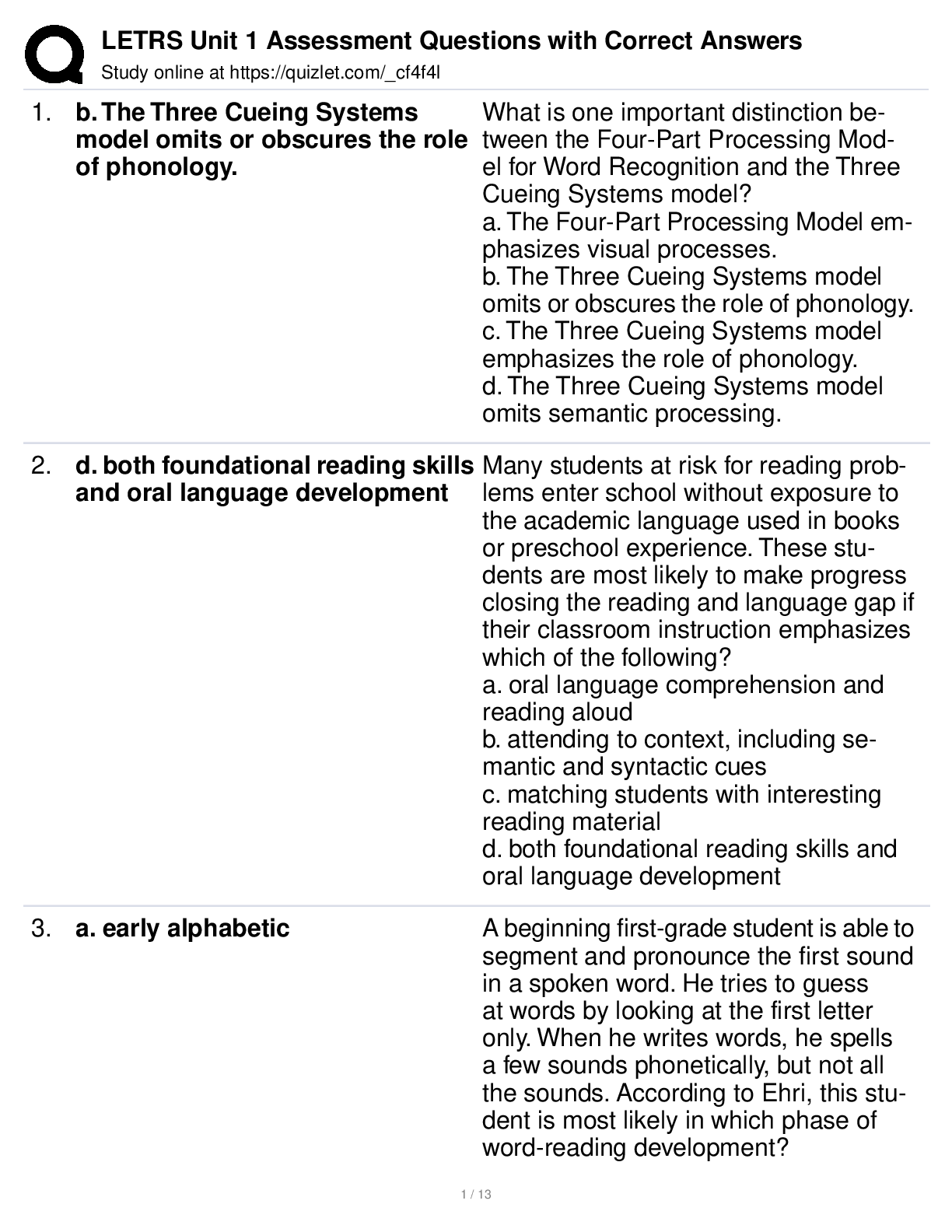


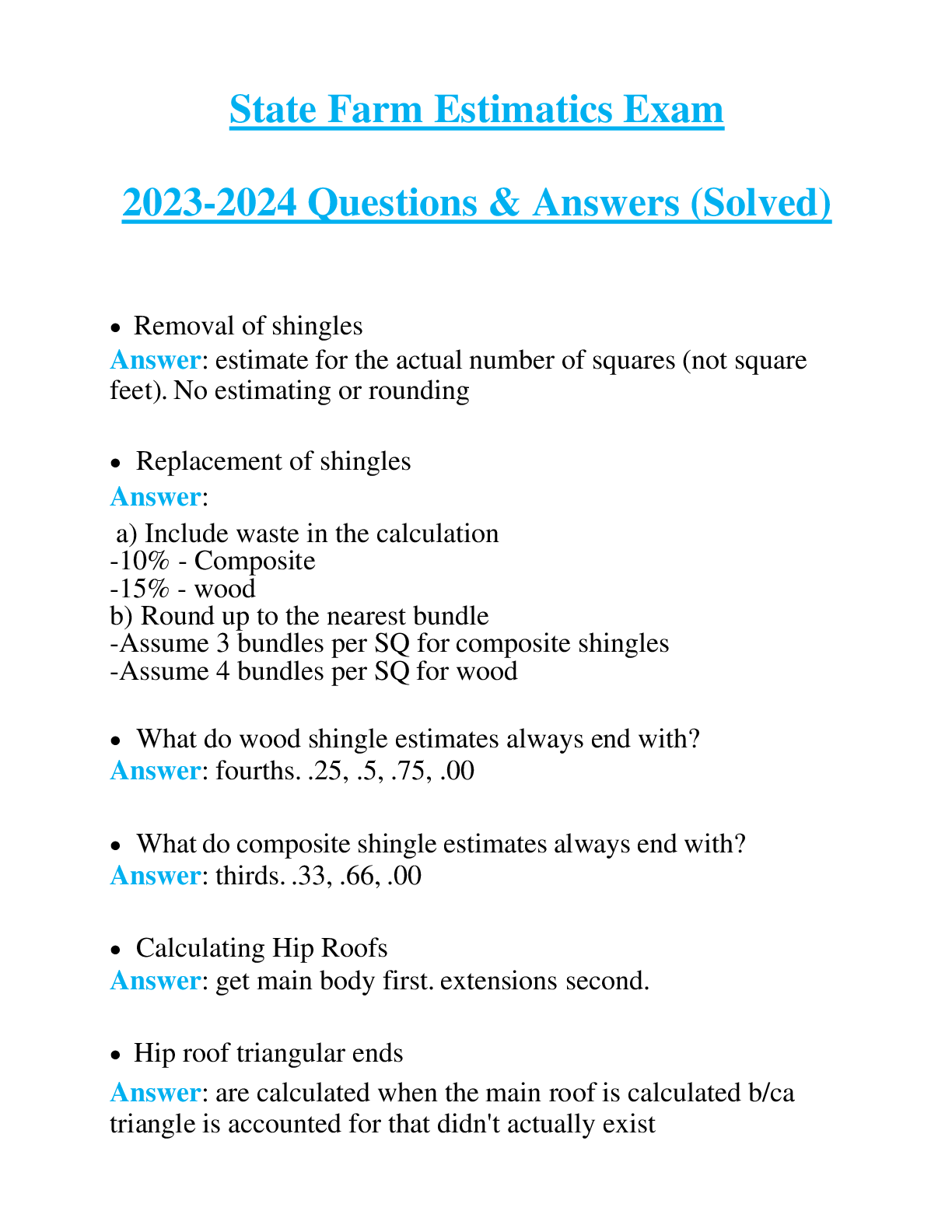
.png)

